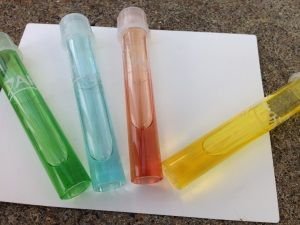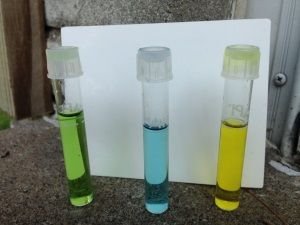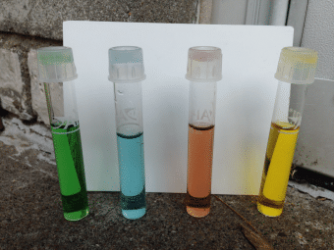I am doing a fishless cycle with 10 gallon tank, heated to 83-85 degrees, bubble stone and using Prime. I set up my tank on May 10th and let it run until May 16th not doing anything (waiting to find pure ammonia source). Aquaclear 20 filter. Everything is brand new in the tank but I did use rocks from an old tank and squeezed some filter media onto the new sponge but there wasn't a lot as it was from a 1.5 gallon tank.
May 16th: Dosed the tank to 4 ppm ammonia (now after reading I realized that was too much)
May 17th: Nothing changed
May 18th: Ammonia 4 ppm, Nitrites 1 ppm (did not test for nitrates), PH: 7.6
May 19th: Ammonia 2 ppm, nitrites 5 ppm, nitrates, 5 ppm, PH: 7.8
May 20th: Ammonia 2 ppm, nitrites 5 ppm, nitrates 5 ppm, PH 7.8
May 21st: Ammonia 1 ppm, nitrites 5 ppm+, nitrates 5 ppm, PH 7.8
Dosed tank with ammonia to 3 ppm
May 22nd: ammonia 2 ppm, nitrites 5+ ppm, nitrates 1-5 ppm, PH 7.8
May 23rd: Did not test
May 24th: ammonia 1-2 ppm, Nitrites 5 ppm, Nitrates 1-5 ppm, PH 8.0
May 25th: ammonia 1 ppm, nitrites 1 ppm, nitrates 10 ppm, PH 8.0
May 26th: ammonia 1 ppm, nitrites .25 ppm, nitrates 1-5 ppm, PH 8.0
Did a 25% water change and waited 1 hour and took my water to LFS to test
Their readings: ammonia .50 ppm, nitrites, .25 ppm, nitrates 15 ppm came home and dosed 2nd dose of ammonia 1 ppm
May 27th: ammonia 1.50 ppm, nitrites 0 ppm, nitrates 1-5 ppm, PH 8.2
I have asked in other forums why my ammonia is never really going down and I've been told to be patient. I followed directions for fishless cycling on another forum and wish I would have started here first. It seems my nitrites have peaked and now are clearly at 0 so I would think that my ammonia would be going down as well but I can't seem to ever get them under 1 ppm. I also use the API Master Test kit and the LFS used a strip. I just want to make sure that I haven't done something wrong or that my cycle is stalled for some reason. My tap water tested .50 ammonia, 0 for nitrates. Sorry for all the information. Any advice is welcome!
May 16th: Dosed the tank to 4 ppm ammonia (now after reading I realized that was too much)
May 17th: Nothing changed
May 18th: Ammonia 4 ppm, Nitrites 1 ppm (did not test for nitrates), PH: 7.6
May 19th: Ammonia 2 ppm, nitrites 5 ppm, nitrates, 5 ppm, PH: 7.8
May 20th: Ammonia 2 ppm, nitrites 5 ppm, nitrates 5 ppm, PH 7.8
May 21st: Ammonia 1 ppm, nitrites 5 ppm+, nitrates 5 ppm, PH 7.8
Dosed tank with ammonia to 3 ppm
May 22nd: ammonia 2 ppm, nitrites 5+ ppm, nitrates 1-5 ppm, PH 7.8
May 23rd: Did not test
May 24th: ammonia 1-2 ppm, Nitrites 5 ppm, Nitrates 1-5 ppm, PH 8.0
May 25th: ammonia 1 ppm, nitrites 1 ppm, nitrates 10 ppm, PH 8.0
May 26th: ammonia 1 ppm, nitrites .25 ppm, nitrates 1-5 ppm, PH 8.0
Did a 25% water change and waited 1 hour and took my water to LFS to test
Their readings: ammonia .50 ppm, nitrites, .25 ppm, nitrates 15 ppm came home and dosed 2nd dose of ammonia 1 ppm
May 27th: ammonia 1.50 ppm, nitrites 0 ppm, nitrates 1-5 ppm, PH 8.2
I have asked in other forums why my ammonia is never really going down and I've been told to be patient. I followed directions for fishless cycling on another forum and wish I would have started here first. It seems my nitrites have peaked and now are clearly at 0 so I would think that my ammonia would be going down as well but I can't seem to ever get them under 1 ppm. I also use the API Master Test kit and the LFS used a strip. I just want to make sure that I haven't done something wrong or that my cycle is stalled for some reason. My tap water tested .50 ammonia, 0 for nitrates. Sorry for all the information. Any advice is welcome!






